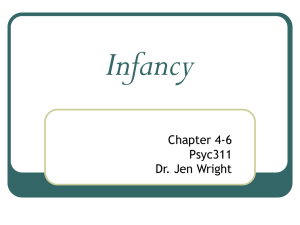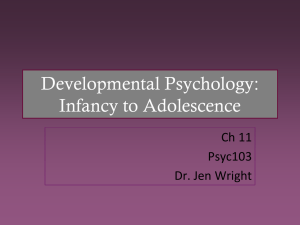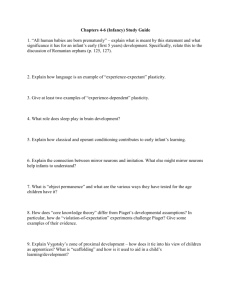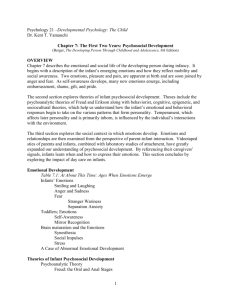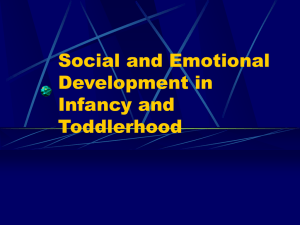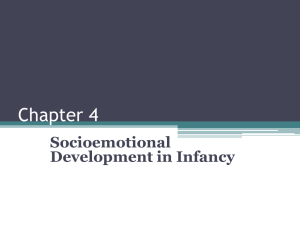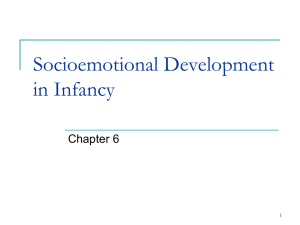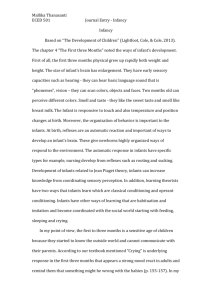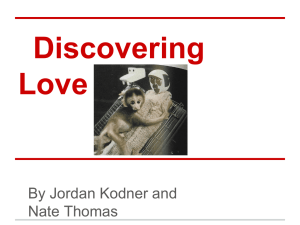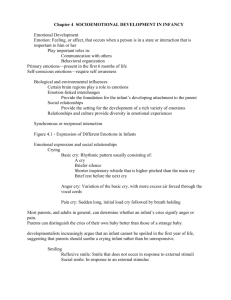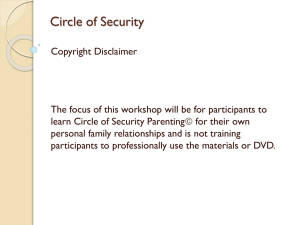Chapter 04-06 Infancy - Jen Wright`s Website
advertisement
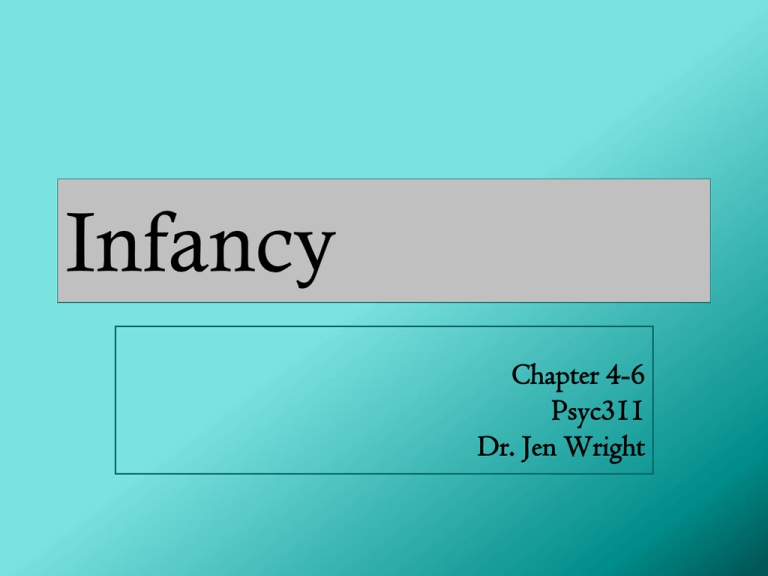
Infancy Chapter 4-6 Psyc311 Dr. Jen Wright infant brain one of the last organs to develop… difference between species • Humans do not have the Species largest brain – but they Human have the largest EQ. Dolphin • Encephalization EQ+IQ Chimpanzee Quotient (EQ) – Average brain mass/body weights for a species. – Average for species/average mammalian value. EQ Species EQ 7.4 Cat 1.0 5.3 Horse 0.9 2.5 Sheep 0.8 Rhesus Monkey 2.1 Mouse 0.5 Elephant 1.9 Rat 0.4 Whale 1.8 Rabbit 0.4 Dog 1.2 2.5 Parrot brain development • Most brain development happens outside (instead of inside) the womb – Monkey newborn 70% adult size – Human newborn 25% adult size • Most growth occurs in first 3 yrs – 3 yrs old 80% adult size – 5 yrs old 90% adult size developmental processes • Neurogenesis – proliferation of neurons through cell division – 250,000 cells “born” every minute • Synaptognesis – formation of connections – Each neuron forms 1000’s of connections – Axons elongate towards specific targets – Dendritic “trees” increases in size and complexity – By 6 months 2 x more synaptic connections developmental processes developmental processes • Synaptic pruning – elimination of excess synapses – Streamlines neural processing – Without synaptic pruning, children wouldn't be able to walk, talk, or even see properly. • Myelination – insulating sheath – Happens at different rates into adolescence – Certain areas are myelinated first patterns of brain growth importance of experience • Plasticity – brain’s ability to change w/ experience • Experience-expectant plasticity (experiences present throughout evolution) – Economizes on material encoded in genes – Development will occur within a normal range of environments Examples? – Level of vulnerability in timing • vision • Sensitive periods • language announcements • Psychology Club Event – Volunteering in the Community – 9/29 (next Weds) 5:15pm, ECTR 116 • Feedback for in-class debate • Group write-ups – pick up after class. • Study session for Exam 01 – 9/29 (next Weds) 7:00pm, ECTR 113 – 35 MC/TF questions (2pts each) – 2 essay q’s (20 pts + 10 pts) – I will give you potential q’s in advance production comprehension both languages 2nd language native language importance of experience • Experience-dependent plasticity (experiences of individual) – Brain sculpted by idiosyncratic experiences – Responsive to richness of environmental stimuli – Important in development of expertise • More brain resources dedicated to processing • E.g. musicians’ cortical representation of hands effect of deprivation effect of deprivation importance of sleep • Regular and ample sleep correlates with normal brain maturation, learning, emotional regulation, and psychological adjustment in school and within the family. importance of sleep importance of sleep • REM sleep – critical for neural development in brain, esp. for activity-dependent development – E.g. visual system – Facilitates learning/memory • Sleep deprivation linked with later problems – E.g. ADHD, learning disabilities • Babies most at risk of disruption – Premature infants in IC units stress and brain development • Exposure to excessive stress hormones is bad for brain development. • Early symptoms of PTSD • The brain can become incapable of producing normal stress responses. – Hyper-vigilance (Ghosts in the Nursery) – Emotional flatness • Physical/emotional abuse and neglect can be equally damaging. what is attachment? attachment theory • Attachment refers to the close, emotional bond between an infant and his/her primary caregiver. • Psychoanalytic Theory (Freud) – Driven by oral needs during the first year – Emphasized early experiences on later outcomes • Behaviorist Perspective (Skinner) – Driven by the need for food – Learns to associate contact with mother with food – Mother’s closeness continually reinforced attachment theory • Ethology (Lorenz) – Rooted in Darwin’s Evolutionary Theory – Focused on the adaptive value of behavior – Bond necessary for survival – Imprinting primary criticisms • Love (i.e., attachment) seen as secondary to instinctive or survival needs • Harlow believed that the need for love and affection was necessary for survival announcments • • • • • Psyc Club – Volunteering in the Community Exam study session Weds, 7-9pm, ECTR113 Friday – Ch 4-6 Ask yourself Q’s due How do you want to spend Friday? – A) lecture – B) ask yourself q’s and study guide! • Exam 01- Monday! Harlow’s monkeys (1958) • Early work with monkeys • Cloth & wire mother – Only one equipped with feeding apparatus – Monkeys randomly assigned – Observed for 5 months • Both groups preferred cloth mother 24 Mean hours per day 18 . . . . . . . 12 . . 6 0 Infant monkey fed on cloth mother Infant monkey fed on wire mother Hours per day spent with cloth mother Contact Time with Wire and Cloth Surrogate Mothers . .. . .. .. . Hours per day spent with wire mother . . 1-5 11-15 21-25 6-10 16-20 Age (in days) Harlow’s monkeys (1958) • http://www.youtube.com/watch?v=hsA5Sec6dAI • http://www.youtube.com/watch?v=caM4f6ZZBE&feature=related attachment theory • John Bowlby – Observations of children in institutionalized care • Infant has built-in behaviors to keep parent close • Gives way to true affectionate bond • Serves 2 purposes – Secure base – Internal working model attachment theory • Mary Ainsworth (1979) – Developed Strange Situation – Work revealed 4 types of attachment behavior • • • • Securely Attached Insecure Avoidant Insecure Resistant Insecure Disorganized • http://www.youtube.com/watch?v=QTsewNrHUHU internal working model cultural variation social learning facial recognition mirror neurons • Found in the frontal and parietal lobes • Fire when you – You engage in an activity (reaching out one’s hand) – You observe someone else engaging in the same activity. • Fire more strongly when action has some purpose or content – reaching out one’s hand for a cup. • MN’s play a clear role in learning/imitation. • May also play a role in “mind-reading” – grasping intentions, goals, desires. emotional communication crying • Crying –communication of emotion • Response to distress – Development of emotional self-regulation • Mastery of environment – agency • Biofeedback loop • Soothing – – – – – Swaddling – tight wrapping of baby in cloth Touch Sweet taste Soft, rhythmic sounds Vibration crying disorders • Colic (1 in 10 infants; birth – 12 weeks) – Extended periods of intense crying – Cause unknown • Immature nervous system • Hyper-sensitivity • Digestive problems • Prolonged crying (beyond 12 weeks) – Exhibit developmental and behavioral disorders crying disorders • Prolonged crying expose the brain to high levels of cortisol, adrenaline, and other damaging chemicals. – – – – – – Damage to hippocampus Reduced levels of vasopressin and serotonin Reduced levels of emotional regulation Impaired memory Increased levels of aggression/violence/bullying Increased levels of anxiety disorders early emotional expression • Earliest emotion – global arousal states of attraction and withdrawal – set the stage for further development – develop into well-organized, sustained signals • Basic emotions – emotions that can be directly inferred from facial expressions. • happiness, interest • surprise, fear, anger • sadness, disgust Basic emotions: A) Universal across all human cultures B) Present in other advanced species C) Include guilt, shame, embarrassment D) A&B E) All of the above emotional self-regulation • Strategies for adjusting emotional state to a comfortable (adaptive) level of intensity in order to accomplish goals • • • • Infants: withdrawal, distress, crying -- need soothing 4 mos: shift focus of attention 1 year: approach/retreat from stimulus Parent response to distress is important • Sympathetic – child more easily soothed, more self-regulated • Non-responsive (wait to intervene) – child enters into rapid, intense distress – harder to soothe – doesn’t develop self-regulation emotional self-regulation • When an infant’s needs are met, they can focus on the world around them and explore. – Their brains take in and adapt to stimulation from the external world. • When they aren’t met, they become fixated on trying to get their needs met. – They stop exploring and shut out other stimulation from the external world. emotions of others • Emotional contagion: babies match the emotional expressions of caregiver 7-10 mos: infants perceive facial expressions as organized patterns, can match facial expression to emotion 8-10 mos: social referencing- relying on another person’s emotional reaction to appraise situation (e.g.- visual cliff) • Still face experiment http://www.youtube.com/watch?v=apzXGEbZht0 Mirror neurons help infants experience others’ emotions: A) Yes, because they help them match emotional facial expressions B) Yes, because they stimulate a matching internal experience C) Yes, because they allow infants to empathize with others. D) A&B E) No, because mn’s are only involved in imitation of physical behavior social referencing • Example of how adults help child regulate emotion • Permits toddlers to compare their assessments of situations with others • Helps young children move beyond simply reacting to emotional messages • Visual cliff experiment http://www.youtube.com/watch?v=eyxMq11xWzM temperament • Constitutionally based individual differences in – – – – Emotion Motor function Attentional reactivity Self-regulation • Influences the way that children develop, display, and control emotions • Foundation for later personality temperament styles • Types – Easy – Difficult – “Slow to warm up” Which child will be harder to reward/punish? A) Easy child B) Difficult child • Differences in sociability • Differences in punishment/reward temperament styles • What else affects the development of temperament? • Gender • Cultural differences • Goodness of fit (with parents/environment) cognitive development theory differences • Piaget stage theory • Child as “blank slate” (everything learned) • Focus on learning as a process within individuals • Core-knowledge theory – Child possesses innate knowledge (domains of thought) • Socio-cultural theory – Focus on learning as a social process between individuals Piaget’s theory • Constructivist approach – children actively construct knowledge for themselves in response to their experiences. • Child as scientist: – Generate hypotheses – Perform experiments – Draw conclusions • Children learn many things on their own – without the help of instruction from adults. • Children are intrinsically motivated to learn. • Discontinuous (qualitative) change – different ages think differently. conservation of quantity (1) conservation of quantity (2) Information processing • Computational approach – cognitive development as a passive maturation process that occurs over time. • Child as a computational system • Children undergo continuous (quantitative) cognitive change • Development through increasingly sophisticated hardware and software – Faster and more efficient processing, larger memory bank, better learning “algorithms” – More content knowledge (learned facts) to draw upon Core-knowledge theories • Child as well-adapted product of evolution • Emphasis on sophistication of children’s thinking in areas that have had evolutionary importance. – Eg. environment navigation, face recognition, language – Naïve physics, psychology, biology • Some advanced capacities already present (innate) • Move from “general” to “domain specific” specialized learning mechanisms Naïve physics • Infants have a surprisingly sophisticated understanding of how the physical world works. understanding intentions • They also have a pretty sophisticated understanding of how the psychological world works – e.g., they understand that there are goals and intentions and that only certain creatures can have them. primitive morality ?
